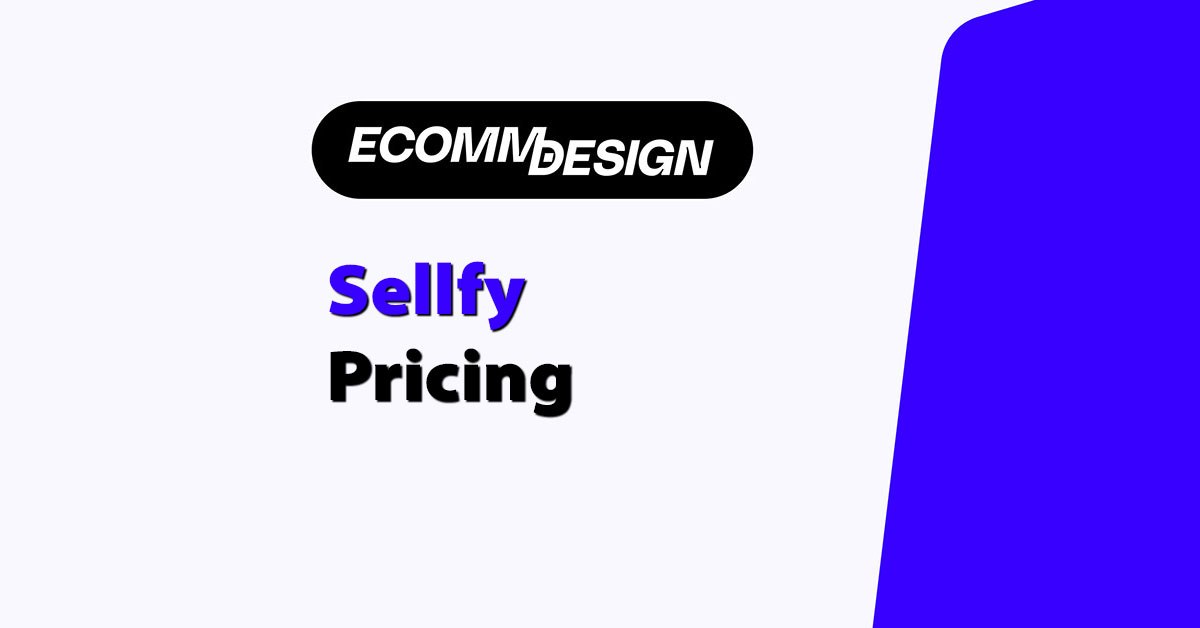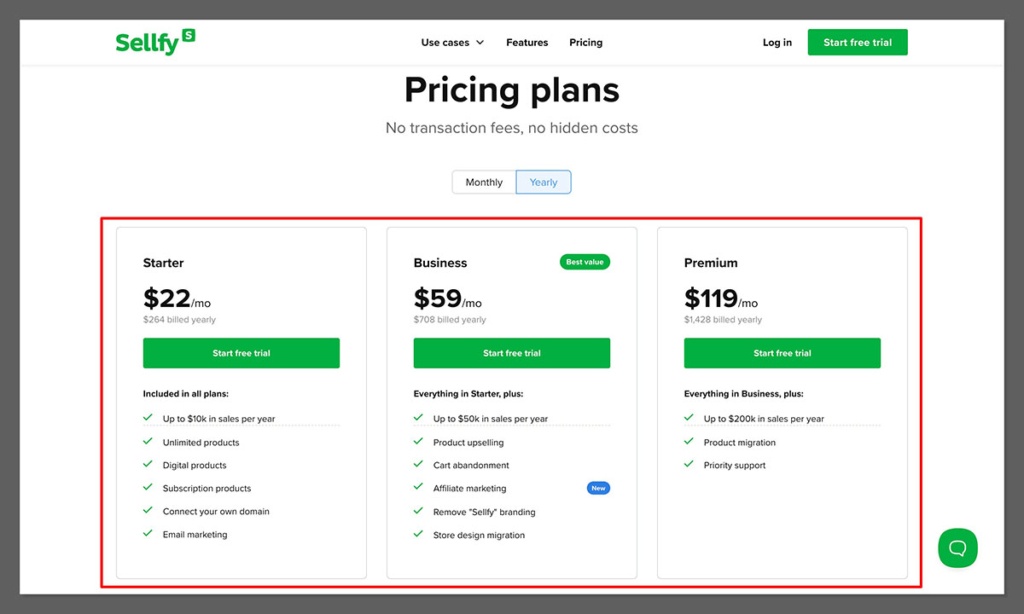
If you’re looking for a simple answer: Sellfy pricing starts at $29/month with two higher tiers at $79/month and $159/month.
You’ll get unlimited products on every plan, no transaction fees, and built-in tools like email marketing and upsells. There’s also a 14-day free trial, no credit card required.
Here’s how it all breaks down — based on real testing and side-by-side comparisons.
What is Sellfy?

Sellfy is a hosted ecommerce platform for creators who want to sell digital downloads, physical products, or subscriptions.
It’s designed to be beginner-friendly, with no need for third-party apps or coding. Everything — from product hosting to checkout, analytics, and email marketing — is handled in one dashboard.
Who it’s best for:
- Digital creators (ebooks, music, presets)
- Online coaches or template sellers
- Small brands selling print-on-demand or merch
- YouTubers and influencers needing a fast store setup
You don’t need a developer or plugins — but you’re also limited to what Sellfy offers out of the box. So it’s not a full Shopify replacement. It’s better suited for simple product businesses and solo entrepreneurs.
Sellfy Pricing Plans (2025)
Sellfy offers three pricing tiers — all with unlimited products and zero transaction fees.
Sellfy Pricing Table
| Plan | Monthly Price | Annual Price (Per Month) | Main Features |
|---|---|---|---|
| Starter | $29/month | $22/month | Digital & physical products, discount codes |
| Business | $79/month | $59/month | Email marketing, product upsells, no Sellfy branding |
| Premium | $159/month | $119/month | Priority support, advanced analytics, 50,000 emails/month |
Annual billing saves up to 25%, depending on the plan. There’s no free plan, but you get a 14-day trial.
What Do You Get With Each Plan?

Each tier unlocks different tools. Here’s a breakdown:
✅ Starter ($29/mo or $22/mo annually)
- Unlimited digital and physical products
- Store customization
- Discount codes
- Embedded checkout
- Basic store analytics
✅ Business ($79/mo or $59/mo annually)
- Everything in Starter
- Product upsells
- Cart abandonment emails
- 10,000 email credits/month
- Remove Sellfy branding
✅ Premium ($159/mo or $119/mo annually)
- Everything in Business
- 50,000 email credits/month
- Advanced analytics (location-based, traffic sources)
- Priority customer support
Things to note:
- You can use Stripe or PayPal to accept payments.
- You’re not charged transaction fees, unlike some competitors.
- If you don’t use the email marketing features, Starter might be enough.
How Sellfy Handles Ecommerce Design and Layout
One of the biggest reasons ecommerce creators choose platforms like Sellfy is how quickly they can build a clean, functioning storefront without hiring a developer.
Here’s what you can and can’t customise depending on your plan:
- Store layout is consistent across all plans. You can edit product pages, homepage blocks, text, and colours.
- Custom fonts and advanced design tweaks like CSS editing are not available — Sellfy is meant to stay simple.
- Sellfy branding is visible on the Starter plan. It’s removed once you upgrade to Business or Premium.
- Responsive design is built-in. Your store works well on desktop and mobile with no extra effort.
If you’re a designer or running a brand that relies heavily on aesthetic, the Business plan is a must to remove Sellfy branding and maintain visual consistency across your store and external marketing.
Read more: Sellfy vs Shopify
Design Limitations to Consider at Each Price Point
| Plan | Store Branding | Layout Control | Mobile UX | Analytics Depth |
|---|---|---|---|---|
| Starter | Sellfy branding visible | Basic | Responsive | Basic |
| Business | Branding removed | Moderate | Responsive | Medium |
| Premium | Branding removed | Moderate | Responsive | Advanced (location, source data) |
Summary:
- Starter is enough for side projects, but the branding and basic design control can limit professional stores.
- Business allows you to present a more polished visual brand and gives you features like upsells to shape buyer flow.
- Premium adds advanced analytics, which helps you make informed design changes based on user behaviour.
How Pricing Impacts the Checkout Experience
Your checkout flow is one of the most important parts of ecommerce design. It’s where decisions happen — and it should feel smooth, branded, and trustworthy.
Here’s what Sellfy allows based on your plan:
- Starter uses a basic one-page checkout with no upsells or cart abandonment recovery.
- Business and Premium unlock features like:
- Product upsells right in the cart
- Cart abandonment emails
- Custom confirmation messaging
- A branding-free environment to keep users inside your design language
These features not only improve conversions but also reduce visual friction — something crucial in ecommerce UX.
Email Design & Automation (By Plan)
Email is part of the design experience too. From confirmation emails to newsletters, it reflects your brand’s tone and layout.
| Plan | Email Credits | Custom Branding | Automation Features |
|---|---|---|---|
| Starter | None | N/A | N/A |
| Business | 10,000/month | Yes | Abandoned cart, campaigns |
| Premium | 50,000/month | Yes | Advanced email control |
- Emails are basic in layout, but they can be branded with your logo and colours.
- You don’t get full HTML control — but what’s there is enough for most creators.
- You can send product updates, marketing messages, or sales campaigns.
If you’re building a brand through consistent design across store and email, Business or Premium gives you the volume and tools to match.
Sellfy vs Competitors: How It Compares on Price
Sellfy is often compared to platforms like Gumroad, Podia, or Shopify Lite. Here’s how the pricing compares.
| Platform | Entry Price | Transaction Fees | Email Marketing | Product Upsells | Hosted Store |
|---|---|---|---|---|---|
| Sellfy | $29/month | 0% | Included (Business+) | Business+ only | Yes |
| Gumroad | Free* | 10% per sale | No | No | Basic |
| Shopify Lite | $9/month | 2.9% + 30¢ | No | No | No store |
| Podia | $39/month | 0% | Included | Yes | Yes |
* Gumroad charges 10% per sale, which can quickly exceed Sellfy’s flat monthly rate.
Key takeaway:
If you sell more than $300/month in products, Sellfy may cost less than Gumroad — even though Gumroad looks cheaper upfront.
Is Sellfy Worth It?
Sellfy is priced for people who want a no-fuss way to sell without building out a full ecommerce site. If you’re a creator selling digital goods and want built-in marketing tools, it’s likely worth the monthly cost.
You’re getting:
- Unlimited products with no extra fees
- Full control of your product pages
- Built-in upsells and email campaigns
- A checkout experience that’s optimised for mobile
When it’s not ideal:
- If you need a full marketplace
- If you need advanced shipping, inventory, or SEO tools
- If you’re managing dozens of products and SKUs
For most small-scale creators, though, it covers the essentials without complexity.
Pros and Cons of Sellfy Pricing
✅ Pros:
- No transaction fees (you keep 100% of your sales)
- Simple pricing structure with annual discounts
- Built-in tools that save costs (email, upsells)
- Unlimited products on all tiers
- 14-day trial with no credit card needed
❌ Cons:
- No free plan
- Limited design flexibility
- Email credits are tied to pricing tier
- No app marketplace or plugin support
- Basic SEO and customisation tools
Who Should Use Which Plan?
Starter Plan is best for:
- Selling digital downloads like ebooks, design templates, or courses
- New creators validating an idea with a lean setup
- Those who don’t need built-in email marketing or upsells yet
- Anyone looking for a minimal storefront to embed on a personal site or portfolio
If you’re focused on clean, simple ecommerce design with just a few products, Starter gives you what you need without extra tools you won’t use yet.
You’ll still have full control over the look and feel of your product pages using Sellfy’s editor.
Business Plan is best for:
- Small ecommerce brands starting to scale
- Creators targeting repeat purchases or abandoned cart recovery
- Store owners who want to remove Sellfy branding for a more polished look
- Businesses using email design as part of their customer experience
From a design point of view, this plan gives your storefront a more professional edge.
Removing Sellfy branding helps maintain consistency with your brand visuals, and upsells allow for smarter product presentation in the cart flow.
Premium Plan is best for:
- High-volume ecommerce sellers with multiple SKUs or product types
- Marketers who rely on segmented email campaigns
- Creators working with a team or managing storefronts with custom funnels
- Brands needing detailed insights into traffic and conversion sources
Premium adds more than just support and email volume — it gives ecommerce designers and marketers deeper control over performance data.
This is helpful if you’re optimising layout, checkout design, or mobile UX based on audience behaviour.
If email is central to your funnel, Business or Premium is where the value kicks in.
If you’ve already got tools like ConvertKit or Mailchimp handling your email workflows, and you’re mainly concerned about site layout and basic transactions, Starter can still do the job.
Final Thoughts on Sellfy Pricing
Sellfy offers a straightforward pricing structure that works well for creators, small ecommerce brands, and digital product sellers who want to avoid complex setup.
With unlimited products and no transaction fees across all plans, the platform keeps costs predictable — which is important when managing tight margins.
From a design perspective, Sellfy’s Business and Premium plans offer more control over branding, customer experience, and marketing automation.
While the platform doesn’t allow full design freedom, it handles the essentials well — especially for those prioritising speed, simplicity, and a clean mobile experience.
If you’re building a digital product store and need a platform that balances affordability, design consistency, and marketing tools without the overhead of plugins or coding,
Sellfy is a solid option worth testing — especially with the 14-day free trial.






